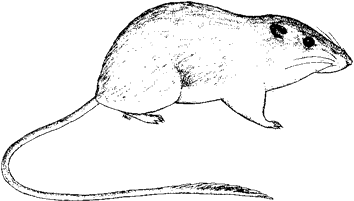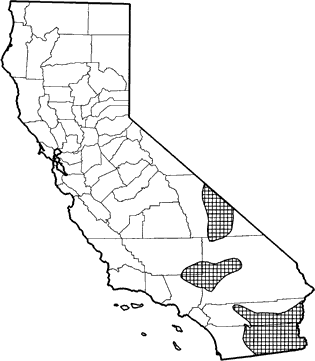
Desert Pocket Mouse
Distribution, Abundance, and Seasonality
In California, occurs in 3 disjunct populations: in Death Valley National Monument, southeastern Kern and northeastern Los Angeles cos. east to central San Bernardino Co., and in the southeast corner of the state from central Riverside Co. east to the Colorado River and south to the border of Mexico. Locally common resident of desert habitats including desert wash, desert succulent shrub, desert scrub, and alkali desert scrub. Elevational range from below sea level (Death Valley) to 820 m (2700 ft).

Range Map
Specific Habitat Requirements
Feeding: Feeds mainly on seeds of forbs, grasses, and shrubs. Forages on sandy or gravelly soils beneath shrub canopy. Seeds are stored in burrow and in dispersed caches. Green vegetation and insects also are eaten (Arnold 1942, Reynolds and Haskell 1949).
Cover: Burrows are excavated in silty, sandy, or gravelly soil and used for refuges, seed storage, and neonatal care. Generally associated with moderate canopy but experimental removal of canopy did not result in fewer desert pocket mice (Rosensweig 1973).
Reproduction: Young are born and raised in nest chambers within the burrow.
Water: No direct evidence, but probably obtains water from food.
Pattern: Silty, sandy, or gravelly substrate with sparse to moderate canopy is preferred.
Species Life History
Activity Patterns: Nocturnal. In California, may be active year-round, though inactive in winter in southern Arizona (Hall 1946, Arnold 1942).
Seasonal Movements / Migration: None.
Home Range: In Arizona, high densities were observed in sandy/gravelly plots with saltbush and mesquite (Arnold 1942). In southern Arizona, home range varied from 0.1 to 0.2 ha (0.25 to 0.5 ac) (Reynolds and Haskell 1949).
Territory: Aggressively solitary. Territory probably equals home range.
Reproduction: Breeds from February to September, though most activity is in April-May (Whitford 1976). Gestation period is 23 days. Litter size averages 4 young (range 1-7) (Reynolds and Haskell 1949, Wilken and Ostwald 1968).
Niche: The desert pocket mouse is a small-bodied granivore, specialized for extreme arid environments. Competitors include other heteromyids, especially Dipodomys merriami, and cricetids. Predators include owls, snakes, and predatory mammals.
Sources & References
California Department of Fish and Game, 1999.
California's Wildlife, Sacramento, CA.
Written by: P. Brylski, reviewed by: H. Shellhammer, edited by: R. Duke
Arnold, L. W. 1942. Notes on the life history of the sand pocket mouse. J. Mammal. 23:339-341. Hall, E. R. 1946. Mammals of Nevada. Univ. California Press, Berkeley. 710pp. Reynolds, H. G., and H. S. Haskell. 1949. Life history notes on Price and Bailey pocket mice of southern Arizona. J. Mammal. 30:150-156. Rosensweig, M. R. 1973. Habitat selection experiments with a pair of coexisting heteromyid rodent species. Ecology 54:111-117. Rosensweig, M. R., and J. Winakur. 1969. Population ecology of desert rodent communities: habitats and environmental complexity. Ecology 50:558-572. Whitford, W. G. 1976. Temporal fluctuations in density and diversity of desert rodent populations. J. Mammal. 57:351-369. Wilken, K. K., and R. Ostwald. 1968. Partial contact as a stimulus to laboratory mating in the desert pocket mouse, Perognathus penicillatus. J. Mammal. 49:570-572.
California Animal Facts | California's Wildlife